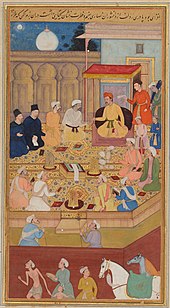Syncretism
This articleneeds additional citations forverification.(July 2015) |

Syncretism(/ˈsɪŋkrətɪzəm,ˈsɪn-/)[1]is the practice of combining different beliefs and variousschools of thought.Syncretism involves the merging orassimilationof several originally discretetraditions,especially in thetheologyandmythologyofreligion,thus asserting an underlying unity and allowing for aninclusiveapproach to other faiths. While syncretism inartandcultureis sometimes likened toeclecticism,in the realm of religion, it specifically denotes a more integrated merging of beliefs into a unified system, distinct from eclecticism, which implies a selective adoption of elements from different traditions without necessarily blending them into a new, cohesive belief system. Syncretism also manifests inpolitics,known assyncretic politics.
Nomenclature
[edit]The English word is first attested in the early 17th century[2]It is fromModern Latinsyncretismus,drawing on theAncient Greek:συγκρητισμός,romanized:synkretismos,supposedly meaning "Cretan federation"; however, this is a spurious etymology from the naive idea inPlutarch's 1st-century AD essay on "Fraternal Love (Peri Philadelphias)" in his collectionMoralia.He cites the example of theCretans,who compromised and reconciled their differences and came together in alliance when faced with external dangers. "And that is their so-calledSyncretism[Union of Cretans] ". More likely as an etymology is sun- (" with ") plus kerannumi (" mix ") and its related noun," krasis "," mixture ".
Social and political roles
[edit]
Overt syncretism in folk belief may show cultural acceptance of an alien or previous tradition, but the "other" cult may survive or infiltrate without authorizedsyncresis.For example, someconversosdeveloped a sort ofcultfor martyr-victims of theSpanish Inquisition,thus incorporating elements ofCatholicismwhile resisting it.
TheKushitekings who ruled Upper Egypt for approximately a century and the whole of Egypt for approximately 57 years, from 721 to 664 BCE, constituting theTwenty-fifth DynastyinManetho'sAegyptiaca,developed a syncretic worship identifying their own godDedunwith the EgyptianOsiris.They maintained that worship even after they had been driven out of Egypt. A temple dedicated to this syncretic god, built by theKushite rulerAtlanersa,was unearthed atJebel Barkal.[3][4]
Syncretism was common during theHellenisticperiod, with rulers regularly identifying local deities in various parts of their domains with the relevant god or goddess of theGreek Pantheonas a means of increasing the cohesion of their kingdom. This practice was accepted in most locations but vehemently rejected by theJews,who considered the identification ofYahwehwith the GreekZeusas the worst of blasphemy.
TheRoman Empirecontinued the practice, first by the identification of traditional Roman deities with Greek ones, producing a singleGreco-Roman pantheon,and then identifying members of that pantheon with the local deities of various Roman provinces.
Some religious movements have embraced overt syncretism, such as the case ofmelding Shintō beliefs into Buddhismor the amalgamation of Germanic and Celticpagan viewsintoChristianityduring its spread into Gaul, Ireland, Britain, Germany and Scandinavia. In later times, Christian missionaries inNorth AmericaidentifiedManitou,the spiritual and fundamental life force in the traditional beliefs of theAlgonquian groups,with theGod of Christianity.Similar identifications were made by missionaries at other locations in the Americas and Africa who encountered a local belief in a Supreme God or Supreme Spirit of some kind.
Indian influences are seen in the practice ofShi'i IslaminTrinidad.Others have strongly rejected it as devaluing and compromising precious and genuine distinctions; examples include post-ExileSecond Temple Judaism,Islam,and most ofProtestantChristianity.[further explanation needed][citation needed]
Syncretism tends to facilitate coexistence and unity between otherwise different cultures and world views (intercultural competence), a factor that has recommended it to rulers of multiethnicrealms.Conversely, the rejection of syncretism, usually in the name of "piety"and"orthodoxy",may help to generate, bolster or authenticate a sense of uncompromisedcultural unityin a well-defined minority or majority.
All major religious conversions of populations have had elements from prior religious traditions incorporated into legends or doctrine that endure with the newly convertedlaity.[5]
Religious syncretism
[edit]

Religious syncretism is the blending of two or more religiousbelief systemsinto a new system, or the incorporation into a religious tradition of beliefs from unrelated traditions. This can occur for many reasons, and the latter scenario happens quite commonly in areas where multiple religious traditions exist in proximity and function actively in a culture, or when a culture is conquered, and the conquerors bring their religious beliefs with them, but do not succeed in entirely eradicating the old beliefs or (especially) practices.
Religions may have syncretic elements to their beliefs or history, but adherents of so-labeled systems often frown on applying the label, especially adherents who belong to "revealed" religious systems, such as theAbrahamic religions,or any system that exhibits anexclusivistapproach. Such adherents sometimes see syncretism as a betrayal of their pure truth. By this reasoning, adding an incompatible belief corrupts the original religion, rendering it no longer true. Indeed, critics of a syncretistic trend may use the word or its variants as a disparaging epithet, as a charge implying that those who seek to incorporate a new view, belief, or practice into a religious system pervert the original faith. Non-exclusivist systems of belief, on the other hand, may feel quite free to incorporate other traditions into their own. Keith Ferdinando notes that the term "syncretism" is an elusive one,[6]and can refer to substitution or modification of the central elements of a religion by beliefs or practices introduced from elsewhere. The consequence under such a definition, according to Ferdinando, can lead to a fatal "compromise" of the original religion's "integrity".[7]
In modernsecularsociety, religious innovators sometimes construct new faiths or key tenets syncretically, with the added benefit or aim of reducing inter-religious discord. Such chapters often have a side-effect of arousing jealousy and suspicion among authorities and ardent adherents of the pre-existing religion. Such religions tend to inherently appeal to an inclusive, diverse audience. Sometimes the state itself sponsored such new movements, such as theLiving Churchfounded inSoviet Russiaand theGerman Evangelical ChurchinNazi Germany,chiefly to stem all outside influences.
Cultures and societies
[edit]According to some authors, "Syncretism is often used to describe the product of the large-scale imposition of one alien culture, religion, or body of practices over another that is already present."[8]Others such asJerry H. Bentley,however, have argued that syncretism has also helped to create cultural compromise. It provides an opportunity to bring beliefs, values, and customs from one cultural tradition into contact with, and to engage different cultural traditions. Such a migration of ideas is generally successful only when there is a resonance between both traditions. While, as Bentley has argued, there are numerous cases where expansive traditions have won popular support in foreign lands, this is not always so.[9]
Din-i Ilahi
[edit]
In the 16th century, theMughal emperorAkbarproposed a new religion called theDin-i Ilahi( "Divine Faith" ). Sources disagree with respect to whether it was one of many Sufi orders or merged some of the elements of the various religions of his empire.[10][11]Din-i Ilahi drew elements primarily fromIslamandHinduismbut also fromChristianity,Jainism,andZoroastrianism.More resembling apersonality cultthan a religion, it had no sacred scriptures, no priestly hierarchy, and fewer than 20 disciples, all hand-picked by Akbar himself. It is also accepted that the policy ofsulh-i-kul,which formed the essence of the Dīn-i Ilāhī, was adopted by Akbar as a part of general imperial administrative policy.Sulh-i-kulmeans "universal peace".[12][13]
Enlightenment
[edit]The syncreticdeismofMatthew Tindalundermined Christianity's claim to uniqueness.[14]The modern, rational, non-pejorative connotations of syncretism arguably date fromDenis Diderot'sEncyclopédiearticlesEclecticismeandSyncrétistes, Hénotiques, ou Conciliateurs.Diderot portrayed syncretism as the concordance of eclectic sources. Scientific or legalistic approaches of subjecting all claims tocritical thinkingprompted at this time much literature in Europe and the Americas studying non-European religions such as Edward Moor'sThe Hindu Pantheonof 1810, much of which was almost evangelistically appreciative by embracing spirituality and creating the space and tolerance in particulardisestablishment of religion(or its stronger form, official secularisation as in France) whereby believers ofspiritualism,agnosticism,atheistsand in many cases more innovative or pre-Abrahimic based religions could promote and spread their belief system, whether in the family or beyond.[citation needed]
See also
[edit]- Confederacy
- Conflation
- Cultural appropriation
- Cultural assimilation
- Multiculturalism
- Multiple religious belonging
- Religious pluralism
Notes
[edit]- ^"syncretism".Dictionary.com Unabridged(Online). n.d.
- ^TheOxford English Dictionaryfirst attests the wordsyncretismin English in 1618.
- ^Kendall, Timothy; Ahmed Mohamed, El-Hassan (2016)."A Visitor's Guide to The Jebel Barkal Temples"(PDF).The NCAM Jebel Barkal Mission.Khartoum: Sudan. Nubian Archeological Development Organization (Qatar-Sudan): 34 & 94.
- ^Török, László (2002).The Image of the Ordered World in Ancient Nubian Art: The Construction of the Kushite Mind, 800 BC–300 AD.Probleme der Ägyptologie. Vol. 18. Leiden: Brill. p. 158.ISBN9789004123069.
- ^Olupona, Jacob K. (2014).African Religions: A Very Short Introduction.Oxford:Oxford University Press.p. 34.ISBN978-0-19-979058-6.OCLC839396781.
- ^Ferdinando, K. (1995)."Sickness and Syncretism in the African Context"(PDF).In Antony Billington; Tony Lane; Max Turner (eds.).Mission and Meaning: Essays Presented to Peter Cotterell.Paternoster Press.ISBN978-0853646761.
- ^
Ferdinando, Keith (1995). "Sickness and Syncretism in the African Context". In Billington, Antony;Turner, Max(eds.).Mission and Meaning: Essays Presented to Peter Cotterell(PDF).Paternoster Press. p. 272.ISBN978-0853646761.Retrieved2018-06-30.
The Christian faith is inevitably assimilated in terms of the existing structures of thought of its adherents, whatever their culture. Nevertheless, there are points at which the worldview of any people will be found to be incompatible with central elements of the gospel; if conversion to Christianity is to be more than purely nominal, it will necessarily entail the substantial modification of the traditional worldview at such points. Where this does not occur it is the Christian faith which is modified and thus relativised by the worldview, and the consequence is syncretism. [...] The term 'syncretism' [...] is employed here of the substitution or modification of central elements of Christianity by beliefs of practices introduced from elsewhere. The consequence of such a process is fatally to compromise its integrity.
- ^Peter J. Claus and Margaret A. Mills,South Asian Folklore: An Encyclopedia:(Garland Publishing, Inc., 2003).
- ^Jerry Bentley,Old World Encounters: Cross-Cultural Contacts and Exchanges in Pre-Modern Times(New York: Oxford University Press, 1993), viii.
- ^"Dīn-i Ilāhī | Indian religion".Encyclopedia Britannica.Retrieved2021-02-25.
- ^Roychoudhury, Makhanlal (1941).The Din-i-Ilahi, or, The Religion of Akbar.University of Calcutta. p. 306.OCLC3312929.
Din-i-Ilahi... was not a new religion; it was a Sufi order... in which all the principles enunciated are to be found in the Quran and in the practices in the contemporary Sufi orders.
- ^"Why putting less Mughal history in school textbooks may be a good idea".7 March 2016.[verification needed]
- ^"Finding Tolerance in Akbar, the Philosopher-King".10 April 2013.[verification needed]
- ^Harding, A.J. (1995).The Reception of Myth in English Romanticism.Tall Buildings and Urban Environment. University of Missouri Press.ISBN978-0-8262-1007-4.Retrieved2023-02-11.
Further reading
[edit]- .Encyclopædia Britannica.Vol. 26 (11th ed.). 1911.
- Assmann, Jan(1997).Moses the Egyptian: The Memory of Egypt in Western Monotheism.Harvard University Press.ISBN978-0-674-58738-0.
- Assmann, Jan(2008). "Translating Gods: Religion as a Factor of Cultural (Un)Translatability". In de Vries, Hent (ed.).Religion: Beyond a Concept.Fordham University Press.ISBN978-0823227242.
- HadžiMuhamedović, Safet (2018)Waiting for Elijah: Time and Encounter in a Bosnian Landscape.New York and Oxford: Berghahn Books.
- HadžiMuhamedović, Safet (2018)"Syncretic Debris: From Shared Bosnian Saints to the ICTY Courtroom".In: A. Wand (ed.)Tradition, Performance and Identity Politics in European Festivals(special issue ofEthnoscripts20:1).
- Cotter, John (1990).The New Age and Syncretism, in the World and in the Church.Long Prairie, Minn.: Neumann Press. 38 p.N.B.: The approach to the issue is from a conservative Roman Catholic position.ISBN0-911845-20-8
- Pakkanen, Petra (1996).Interpreting Early Hellenistic Religion: A Study Based on the Mystery Cult of Demeter and the Cult of Isis.Foundation of the Finnish Institute at Athens.ISBN978-951-95295-4-7.
- Smith, Mark S.(2010) [2008].God in Translation: Deities in Cross-Cultural Discourse in the Biblical World.Eerdmans.ISBN978-0-8028-6433-8.
External links
[edit] Media related toSyncretismat Wikimedia Commons
Media related toSyncretismat Wikimedia Commons
